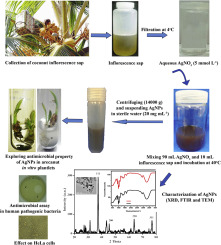Biomaterials Advances ( IF 7.9 ) Pub Date : 2020-03-10 , DOI: 10.1016/j.msec.2020.110834 Rajesh M.K. , Muralikrishna K.S. , Swapna S. Nair , Kumar B. Krishna , Subrahmanya T.M. , Sonu K.P. , Subaharan K. , Sweta H. , Prasad T.S. Keshava , Chandran Neeli , Indrani Karunasagar , Hebbar K.B. , Anitha Karun

|
Green synthesis of nanoparticles (NPs) involves the use of diverse extracts of biological origin as substrates to synthesize NPs and can overcome the hazards associated with chemical methods. Coconut inflorescence sap, which is unfermented phloem sap obtained by tapping of coconut inflorescence, is a rich source of sugars and secondary metabolites. In this study, coconut inflorescence sap was used to synthesize silver NPs (AgNPs). We have initially undertaken metabolomic profiling of coconut inflorescence sap from West Coast Tall cultivar to delineate its individual components. It was found to comprise of 64% secondary metabolites, 9% sugars, 12% lipids/fats and 9% peptides in positive mode, whereas in the negative mode, it was 33, 20, 9 and 11%, respectively. The concentration of silver nitrate, inflorescence sap and incubation temperature for the synthesis of AgNPs were optimized. Incubating the reaction mixture at 40 °C was found to enhance AgNP synthesis. The AgNPs synthesized were characterized using UV–visible (UV-Vis) spectrophotometry, X-Ray Diffraction (XRD), Fourier Transform Infrared spectroscopy (FTIR) and Transmission Electron Microscopy (TEM). The particles were crystalline in nature and the bulk of the particles were spherical with smooth (thin) shell and poly-dispersed with a diameter ranging from 10 nm to 30 nm. Antimicrobial property of AgNPs was tested in tissue culture of arecanut (Areca catechu L.) where bacterial contamination (Bacillus pumilus) was a frequent occurrence. A significant reduction in the contamination was observed when plantlets were treated with aqueous solutions of AgNPs. Notably, treatment with AgNPs did not affect the growth and development of the arecanut plantlets. Antimicrobial properties of AgNPs synthesized from inflorescence sap were also evaluated in human pathogenic bacteria viz., Escherichia coli ATCC 25922; Salmonella Typhimurium ATCC 14028 and Vibrio parahaemolyticus AQ4037. The antibacterial action was confirmed by determining the production of reactive oxygen species (ROS) and protein leakage studies. Cytotoxicity of AgNPs was quantified in HeLa cells. The viability (%) of HeLa cells declined significantly at 10 mg L−1 concentration of AgNP and complete mortality was observed at a concentration of 60 mg L−1. The study concludes that unfermented inflorescence sap, with above neutral pH, serves as an excellent reducing agent to synthesize AgNPs from Ag+.
中文翻译:

便捷的椰子花序汁液介导的银纳米颗粒的合成及其多种抗菌和细胞毒性
纳米颗粒(NPs)的绿色合成涉及使用多种生物来源的提取物作为底物来合成NPs,并且可以克服化学方法带来的危害。椰子花序汁液是通过提取椰子花序获得的未发酵韧皮部汁液,是糖和次级代谢产物的丰富来源。在这项研究中,椰子花序汁液用于合成银纳米粒(AgNPs)。我们最初对来自西海岸高种的椰子花序汁液进行了代谢组学分析,以描述其各个组成部分。发现以正模式包含64%的次级代谢产物,9%的糖,12%的脂质/脂肪和9%的肽,而在负模式下,分别为33%,20%,9%和11%。硝酸银的浓度 优化了用于合成AgNPs的花序汁液和培养温度。发现将反应混合物在40℃下孵育可增强AgNP的合成。合成的AgNPs用紫外可见光(UV-Vis)分光光度法,X射线衍射(XRD),傅里叶变换红外光谱(FTIR)和透射电子显微镜(TEM)进行表征。颗粒本质上是结晶的,并且大部分颗粒是球形的,具有光滑的(薄的)壳,并且直径为10nm至30nm范围内的多分散。在槟榔组织培养中测试了AgNPs的抗菌性能(傅立叶变换红外光谱(FTIR)和透射电子显微镜(TEM)。所述颗粒本质上是结晶的,并且大部分颗粒是球形的,具有光滑的(薄的)壳,并且是直径在10nm至30nm范围内的多分散的。在槟榔组织培养中测试了AgNPs的抗菌性能(傅立叶变换红外光谱(FTIR)和透射电子显微镜(TEM)。颗粒本质上是结晶的,并且大部分颗粒是球形的,具有光滑的(薄的)壳,并且直径为10nm至30nm范围内的多分散。在槟榔组织培养中测试了AgNPs的抗菌性能(槟榔(Bacillus pumilus)经常发生的槟榔(槟榔)。当用AgNPs水溶液处理幼苗时,观察到污染的显着降低。值得注意的是,用AgNPs处理不会影响槟榔苗的生长和发育。还评估了由花序汁液合成的AgNPs的抗微生物特性,即人致病细菌,即大肠杆菌ATCC 25922;大肠杆菌。鼠伤寒沙门氏菌ATCC 14028和副溶血性弧菌AQ4037 。通过确定活性氧(ROS)的产生和蛋白质泄漏研究来确认其抗菌作用。在HeLa细胞中定量了AgNPs的细胞毒性。在10 mg L -1的AgNP浓度下,HeLa细胞的存活率(%)显着下降,在60 mg L -1的浓度下观察到完全死亡。研究得出的结论是,高于中性pH的未发酵的花序汁液可作为从Ag +合成AgNP的极佳还原剂。



























 京公网安备 11010802027423号
京公网安备 11010802027423号